The Great Digital Shift In Accounts Payables Is Just Beginning

Beyond the great digital shift in consumer payments lies fertile ground for a shift in how businesses pay one another.
To that end, Corporate Spending Innovations (CSI) President David Disque said in an interview with Karen Webster, much has changed across the B2B landscape — perhaps for the better, as more purchasing is done remotely, exposing pain points in accounts payable (AP) management.
At a high level, he said, the general recovery in payments processing “is moving at a slow pace. It’s moving along a long U-shaped recovery curve.” Suppliers are more open to taking digital payments than they have been in the past, while buyers have been tapping into working capital lines. But as they navigate the pandemic challenges, businesses are being forced to re-evaluate and digitize many of the manual legacy processes that they’ve been comfortable with for years.
As Disque told Webster, there has been an acceleration of the digitization — and cloud-based workflow — across companies’ operations, particularly AP. That embrace of automated and tech-enabled workflows has spurred collaborative partnerships between traditional financial institutions (FIs) and FinTechs as they seek to modernize (but still adhere to the tenets of) in-place internal, legacy processes.
The Check is (No Longer) in the Mail
“It’s ridiculous to think that people would still have to go into an office to sign checks or conduct manual processes, especially with the tools available today,” he said. “Companies are migrating processes to more efficient cloud-based environments that, at the end of the day, are more secure than mailing a box of checks to another office to be reviewed and signed.”
He noted that as the pandemic hit, the initial surge in CSI’s customer demand came from middle-market firms that were still printing paper checks — and that reached out to CSI to outsource and digitize those efforts (which weren’t core business functions anyway, so outsourcing made sense from a cost-and-labor savings point of view).
Looking beyond the pivot away from paper checks, Disque said that much of the digital transformation of B2B — toward a digital-first mindset — will get its cue from the consumer commerce experience. After all, consumers are business owners, too.
“Consumers still use a lot of cash,” said Disque, “but I can’t think of the last time I wrote a paper check to pay a business or walked into a retailer and wrote a check.”
There’s been an acceleration, especially amid the pandemic, in consumer use of tap to pay and mobile transactions.
“The things you are seeing in the consumer world are going to cascade into the B2B world,” he said.
Drill down a bit, and the movement toward digital B2B AP management requires attention to nuance. Invoices must be matched to purchase orders and enhanced data and reconciliation (across platforms such as CSI’s, which connect to several invoice automation providers) can streamline automated payment decisioning (across payment such as virtual cards, in the event of net payment terms, or ACH or eChecks).
He said the trend would be an inexorable one, where more data will flow as the payments ecosystem becomes ever-more connected. There’ll be standardization between platforms, Disque predicted, that is not yet there today — an end-to end-ecosystem approach that will connect stakeholders across application programming interfaces (APIs) with greater transparency.
In one example of cash flow in, he said, CSI (which does a lot of work across the media space) connected a large advertiser with its merchant acquirer gateway through an API. Payments came through that connection, instead of the advertiser receiving thousands of electronic remittances, requiring huge human capital effort in the back office. Connecting through an API allows the company to connect through CSI to merchant acquirers and gateways — with enhanced data flowing across enterprise resource planning (ERP) and accounts receivable (AR) systems and automated payments. The net impact: improving days sales outstanding by $2 million daily.
Disque said that the role of a platform such as CSI’s is to connect all of these ecosystem partners to make an optimal and holistic decision when a payment comes in, subject to rules in place. Considerations include the types of payments (a card payment, for example), whether those payments can be made through, say, email remittance, a straight-through process, and the appropriate channel (such as BillTrust, Boost or Mastercard Track).
Robotic process automation tools can help automate up to 50 percent of payments digitally, without the human touch, maintained Disque.
The pandemic has also fostered collaboration between traditional FIs and FinTechs, said Disque, leveraging each’s strengths and assets.
“Banks are really good at treasury management,” he said. “They’ve got regulatory and compliance structures in place that are critically important to the payments ecosystem. They’ve got the payment rails too.”
FinTechs and platforms, he said, offer connectivity, acting as the invisible engine that moves the data and standardized processes needed to power greater efficiency in AR and AP management.
“We’re still at the beginning of bringing full automation between buyers and suppliers,” he said.
